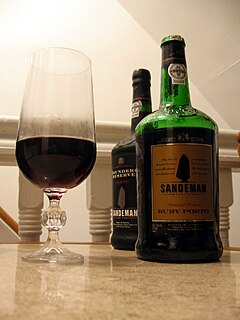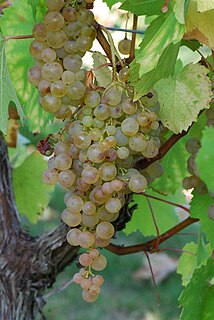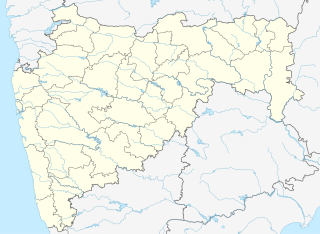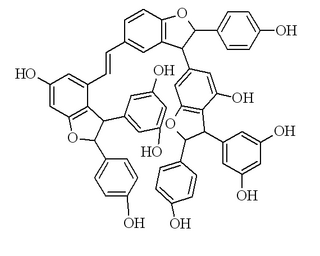 W
WAustralia has over 160 grape varieties distributed on 146,244 hectares (ha) across all six states, South Australia, New South Wales, Victoria, Western Australia, Tasmania and Queensland. These activities are concentrated in the southern part of the continent and only where the terroir - that is, soil types, local climate, availability of irrigation and so on - is suited to viticulture.
 W
W W
WAccording to the Method of Punctuation of the Plots of Land of Vineyards of the Region of Douro, there were 30 recommended and 82 permitted grape varieties in Port wine production. The quality and characteristics of each grape varies with the classification of grape varieties making a distinction between "Very Good", "Good", "Average", "Mediocre" and "Bad" quality grapes. But this classification is actually in revaluation based on the technical and scientific data of the CEVD. The six most widely used grapes for red Port wine are Touriga Franca, Tinta Roriz, Tinta Barroca, Touriga Nacional, Tinta Cão and Tinta Amarela.
 W
WThrough centuries of viticulture and vinification Portugal has developed many unique grape varieties which are used in producing a wide array of different wines. The relative absence of many international varieties such as Cabernet Sauvignon, Chardonnay and Semillon is another characteristic of this country's wine industry, although many of these varieties are now in limited use. At the same time, because of their ability to grow in hot, dry environments, many of Portugal's grape varieties have been planted in similar international locations such as California, South Africa and Australia.
 W
WBangalore blue grape, also simply called Bangalore Blue, is a variety of fox grape grown in districts around Bangalore in India. It is one of the three major varieties of grape in the state of Karnataka. It received a geographical indication tag from the Government of India in 2013.
 W
WA division of grape varieties into Frankish and Hunnic grape varieties was practiced in German-speaking countries in the Middle Ages and separated varieties considered to be better from those considered to be lesser. Frankish (fränkisch) grapes were considered noble grapes, and the designation derived from the Franks, as popular belief held that those were grapes introduced by Charlemagne or at least through his edicts. Hunnic grapes, on the other hand, were the simpler varieties.
 W
WIncrocio Manzoni or Manzoni grapes is a family of grape varieties named after Professor Luigi Manzoni (1888-1968) of Italy's oldest school of oenology located in Conegliano, in the Veneto region. Manzoni created the new grape varieties by selecting, crossing and grafting vines from various vineyards during the 1920s and 1930s. The family includes both white and red grape varieties. Although most Manzonis are grown in northeastern Italy, they are mainly grown in the Piave area of Province of Treviso and are only now starting to be sold commercially in Europe and the United States.
 W
WAn international variety is a grape variety that is widely planted in most of the major wine producing regions and has widespread appeal and consumer recognition. These are grapes that are highly likely to appear on wine labels as varietal wines and are often considered benchmarks for emerging wine industries. There is some criticism that the popularity of so-called international varieties comes at the price of a region's indigenous varieties. The majority of declared international varieties are French in origin, though in recent years the popularity of Spanish and Italian varietals has seen an increase in worldwide plantings and these may also be considered "international varieties".
 W
WNashik grape is a variety of grape produced in Nashik district, which is known as the "grape capital of India". Nashik contributes to more than half of the total grape export from the country.
 W
WThe Pixie Grape is a new type of Vitis vinifera cultivar. The Pixie is a natural dwarf grapevine that is derived from the periclinal L1/L2 chimera Pinot Meunier. These dwarf grapevines tend to have short internodes and prefer to grow flowers instead of tendrils. They grow from 1 foot to 2 feet in height and produce clusters with a size on average of 4 inches. It is simple to cultivate in greenhouses and grows year round. Its purpose was to create an easy tool with which to conduct grapevine research. The grape was developed by grape rootstock breeder Dr. Peter Cousins of the USDA.
 W
WThe scuppernong is a large variety of muscadine, a species of grape native to the Southern United States. It is usually a greenish or bronze color and is similar in appearance and texture to a white grape, but rounder and larger and first known as the 'big white grape'. The grape is commonly known as the "scuplin" in some areas of the Deep South. It is also known as the "scufalum", "scupanon", "scupadine", "scuppernine", "scupnun", or "scufadine" in some parts of the South. The scuppernong is the state fruit of North Carolina.
 W
WTasgaon pronunciation (help·info) is a city and a municipal council in Sangli district in the Indian state of Maharashtra. Tasgaon has rapidly merged with Sangli city as a satellite suburb and will soon become part of Sangali Urban Agglomeration. Tasgaon was given as Jagir to Parshuram Bhau Tasgaonkar by Narayanrao Ballal Peshwa in 1774. Tasgaon sansthan was lapsed by British during ruling of Shrimant Ganapatrao Tasgaonkar.
 W
WTerret is an ancient Vitis vinifera vine that, like the parent Pinot vine of Pinot noir's history, mutated over the course of thousands of years into grape varieties of several color. Originating in the Languedoc-Roussillon wine of southern France, the descendants of Terret now include the red wine variety Terret noir, the white Terret blanc and the light-skinned Terret gris.
 W
WVitis vinifera, the common grape vine, is a species of Vitis, native to the Mediterranean region, Central Europe, and southwestern Asia, from Morocco and Portugal north to southern Germany and east to northern Iran. There are currently between 5,000 and 10,000 varieties of Vitis vinifera grapes though only a few are of commercial significance for wine and table grape production.
 W
WVitisin B is a resveratrol tetramer found in plants of the genus Vitis.